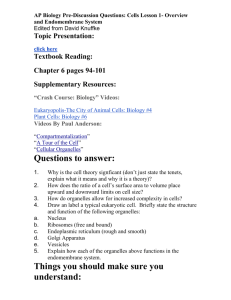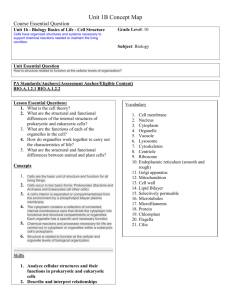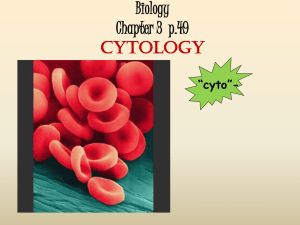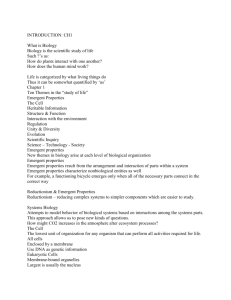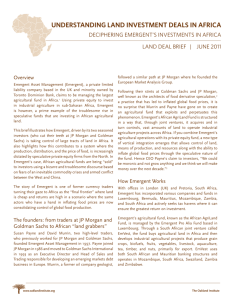AP Biology, Chapter 1 Introduction: Ten Themes in the Study of Life
advertisement
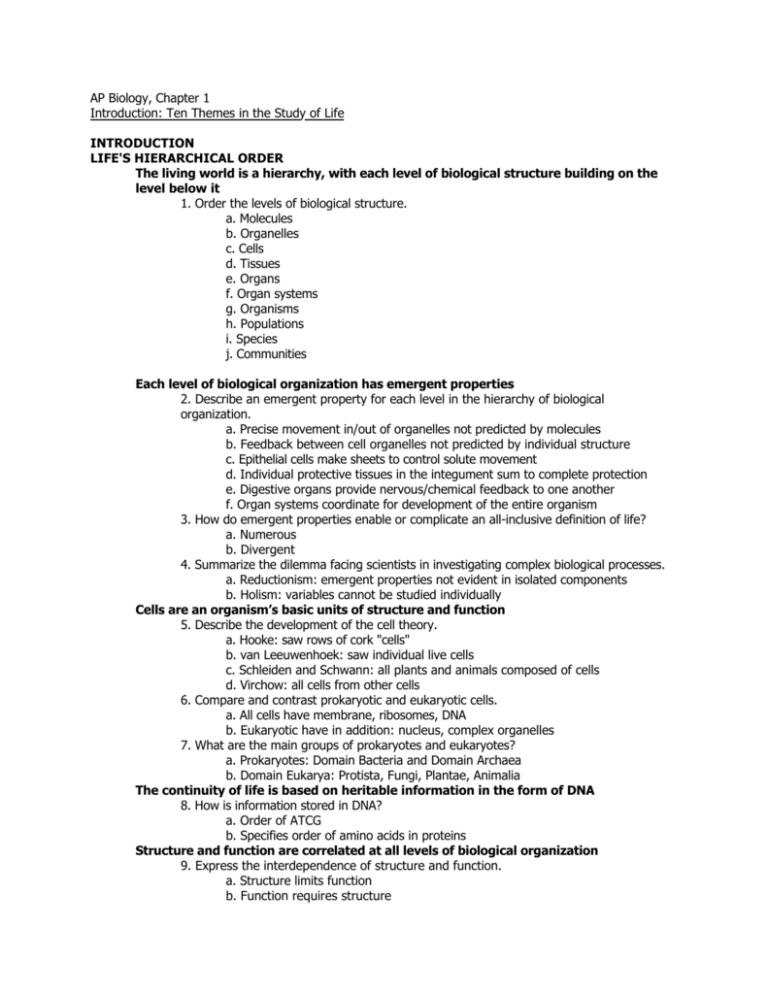
AP Biology, Chapter 1 Introduction: Ten Themes in the Study of Life INTRODUCTION LIFE'S HIERARCHICAL ORDER The living world is a hierarchy, with each level of biological structure building on the level below it 1. Order the levels of biological structure. a. Molecules b. Organelles c. Cells d. Tissues e. Organs f. Organ systems g. Organisms h. Populations i. Species j. Communities Each level of biological organization has emergent properties 2. Describe an emergent property for each level in the hierarchy of biological organization. a. Precise movement in/out of organelles not predicted by molecules b. Feedback between cell organelles not predicted by individual structure c. Epithelial cells make sheets to control solute movement d. Individual protective tissues in the integument sum to complete protection e. Digestive organs provide nervous/chemical feedback to one another f. Organ systems coordinate for development of the entire organism 3. How do emergent properties enable or complicate an all-inclusive definition of life? a. Numerous b. Divergent 4. Summarize the dilemma facing scientists in investigating complex biological processes. a. Reductionism: emergent properties not evident in isolated components b. Holism: variables cannot be studied individually Cells are an organism’s basic units of structure and function 5. Describe the development of the cell theory. a. Hooke: saw rows of cork "cells" b. van Leeuwenhoek: saw individual live cells c. Schleiden and Schwann: all plants and animals composed of cells d. Virchow: all cells from other cells 6. Compare and contrast prokaryotic and eukaryotic cells. a. All cells have membrane, ribosomes, DNA b. Eukaryotic have in addition: nucleus, complex organelles 7. What are the main groups of prokaryotes and eukaryotes? a. Prokaryotes: Domain Bacteria and Domain Archaea b. Domain Eukarya: Protista, Fungi, Plantae, Animalia The continuity of life is based on heritable information in the form of DNA 8. How is information stored in DNA? a. Order of ATCG b. Specifies order of amino acids in proteins Structure and function are correlated at all levels of biological organization 9. Express the interdependence of structure and function. a. Structure limits function b. Function requires structure Organisms are open systems that interact continuously with their environments 10. Describe two major dynamic processes of ecosystems. a. Cycling of nutrients b. Flow f energy Regulatory mechanisms ensure a dynamic balance in living systems 11. Differentiate positive and negative feedback and describe an example of the action of each. a. Two ways to distinguish: effect on stimulus, type of use b. Negative i. Decreases stimulus, used continuously to prevent sudden changes ii. Body temperature, blood sugar c. Positive i. Increases stimulus, used for explosive reactions ii. Blood clotting, childbirth EVOLUTION, UNITY, AND DIVERSITY Diversity and unity are the dual faces of life on Earth 12. Quantitatively express the diversity of life on Earth. a. 5-100 million species 13. What characteristics unite all life on Earth? a. Cell structure b. Genetic code Evolution is the core theme of biology 14. What are the two main concepts presented in The Origin of Species? a. Descent with modification b. Mechanism of modification is natural selection 15. Summarize the components of natural selection. a. Variability b. Struggle for existence c. Differential reproductive success SCIENCE AS A PROCESS Testable hypotheses are the hallmarks of the scientific processes 16. Differentiate inductive and deductive scientific reasoning. a. Inductive: specific to general b. Deductive: general to specific 17. Describe the parts of a controlled experiment. a. Experimental group (subjects receiving new condition) b. Control group (subjects under previous characterized condition) c. Dependent variable (measured) d. Independent variable (changed by design) e. Controlled variables (conditions kept the same for all subjects) Science and technology are functions of society 18. How do science and technology interact in our society? a. Technology applies science b. New technologies enable new experiments Biology is a multidisciplinary adventure REVIEW 19. Briefly describe the unifying themes that pervade the science of biology. a. See bold face above


